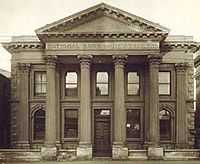Direct bank
Banking A series on financial services |
|---|
 |
|
Types of banks Central bank Advising bank · Commercial bank Community development bank Cooperative bank · Credit union Custodian bank · Depository bank Export credit agency Investment bank · Industrial bank Merchant bank · Mutual savings bank National bank · Offshore bank Postal savings system Private bank · Public bank · Retail Bank Savings and loan association Savings bank · Universal bank more... |
|
Bank cards |
|
Funds transfer Electronic funds transfer Wire transfer · Cheque · SWIFT Automated Clearing House Electronic bill payment · Giro |
|
Banking terms Loan · Money creation Fractional reserve banking Automatic teller machine Bank regulation · Anonymous banking Islamic banking · Private banking Ethical banking |
A direct bank is a bank without any branch network that offers its services remotely via online banking and telephone banking and may also provides access via ATMs (often through interbank network alliances), mail and mobile. By eliminating the costs associated with bank branches, direct banks can make significant savings which they may pass on to clients via higher interest rates or lower service charges.
The concept of a direct bank gained prominence with the advent of online banking technology in the early 1990s which led to a number of direct banks being created, although many were owned by traditional banks. A number of direct banks offer only online savings account and these banks typically offer higher interest rates that their traditional competitors as these banks can be very cost efficient to operate. Since mid-2000s online and telephone banking has become a mainstay of retail banking and most banks have incorporated these into their core services and transforming or reducing their branch network to mirror the advantages that direct banks have.
History
Direct banks were originally based on providing banking services via telephone. One of the world's first fully functional direct banks was First Direct, which launched in the United Kingdom on October 1, 1989. A subsidiary of the then Midland Bank, it pioneered the concepts of no branches and 24-hour service from a call center based in Leeds.
However, it was the commercialization of the Internet in the early 1990s that was the biggest driver in the creation of direct banking models. As the Internet became more generally accessible, traditional banks began to realize its potential to deliver services to their customers while reducing long-term operational costs. Upon realizing this, traditional banks began to offer limited online banking services.
The initial success of internet banking services provided by traditional banks led to the development of internet-only banks or "virtual banks". These banks were designed without a traditional banking infrastructure, a cost-saving feature that allowed many of them to offer savings accounts with higher interest rates and loans with lower interest rates than most traditional banks.
Virtual banks operate virtually from a single PC and server administration without really having any real infrastructure.
One of the first fully functional direct banks in the United States was the Security First Network Bank (SFNB), which began operations on October 18, 1995 [citation needed]. Based in Atlanta, it was the first direct bank to be insured by the Federal Deposit Insurance Corporation (FDIC). After three years of operation, it was acquired by the Royal Bank of Canada (RBC). Though SFNB did not make much profit in its initial years, it demonstrated that the concept of direct banking could work.
One of Europe's first full-service direct banks was First-e, launched by ENBA a Dublin-based internet incubator company under the banking license of French bank, Banque d'Escompte. First launched in the UK in late September 1999, it garnered appreciable attention, resulting in more such ventures all over Europe. After about two years of operations, it shut down its operations during the dot-com bubble bust.[1] Although Egg Bank, launched earlier in October 1998 by Prudential plc, was touted to be a direct bank, it was not a full-service direct bank initially.
Asia's first direct bank was finatiQ, a division of the Oversea-Chinese Banking Corporation (OCBC) of Singapore. It opened on April 3, 2000 (though its public launch was on April 18, 2000), heralding the arrival of virtual banking in Asia. It was shut down in 2011 when its parent OCBC said that "Internet Banking has since become a core part of OCBC Bank’s multi-channel strategy – which also encompasses branches, ATMs and Mobile Banking" and so they saw no need for a separate direct bank any longer.[2]
Noteworthy direct banks around the world
- Ally Bank, part of Ally Financial
- Capital One 360, part of Capital One Financial (originally ING Direct US division)
- First Direct, part of HSBC
- ING Direct, part of ING Group, except in the United States, where it is a part of Capital One
- RaboDirect, part of Rabobank
- UBank, part of National Australia Bank
- ZUNO Bank, part of Raiffeisen Zentralbank or Raiffeisen International Bank
See also
- Online Savings Account
References
- ↑ "Irish Internet Bank Shuts Its Doors". Tax News. September 7, 2001.
- ↑ "FinatiQ to cease operations". Asia Banking and Finance. May 8, 2011.